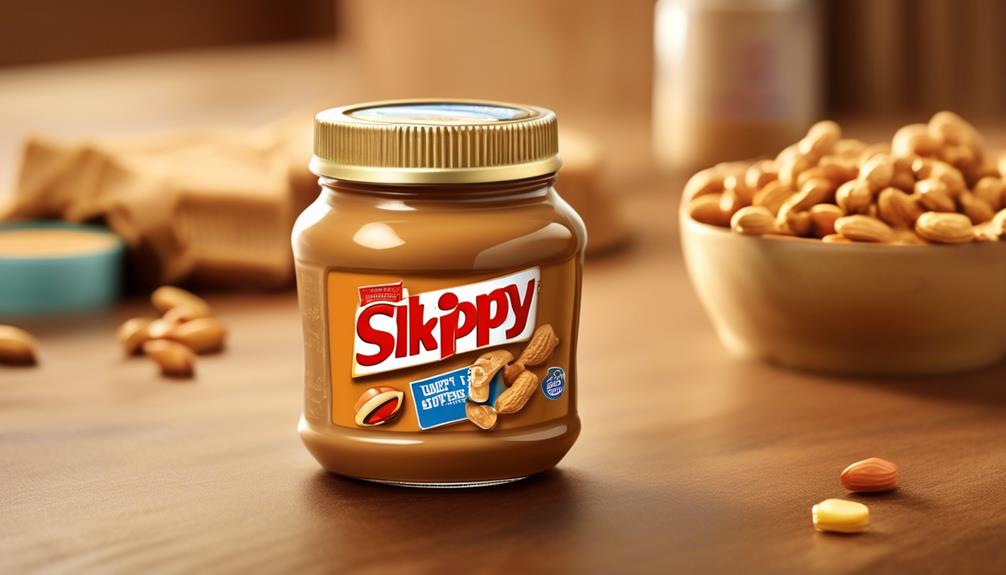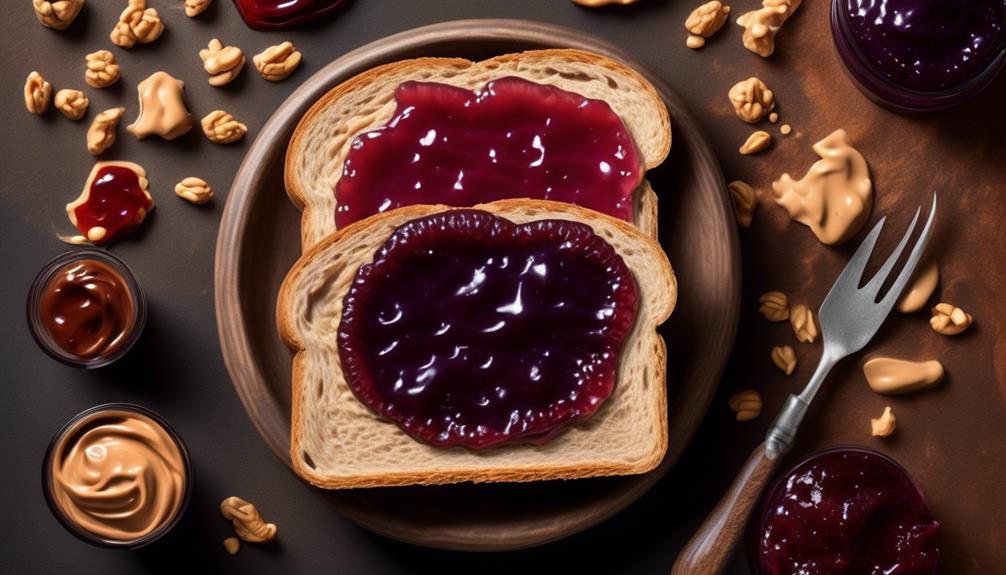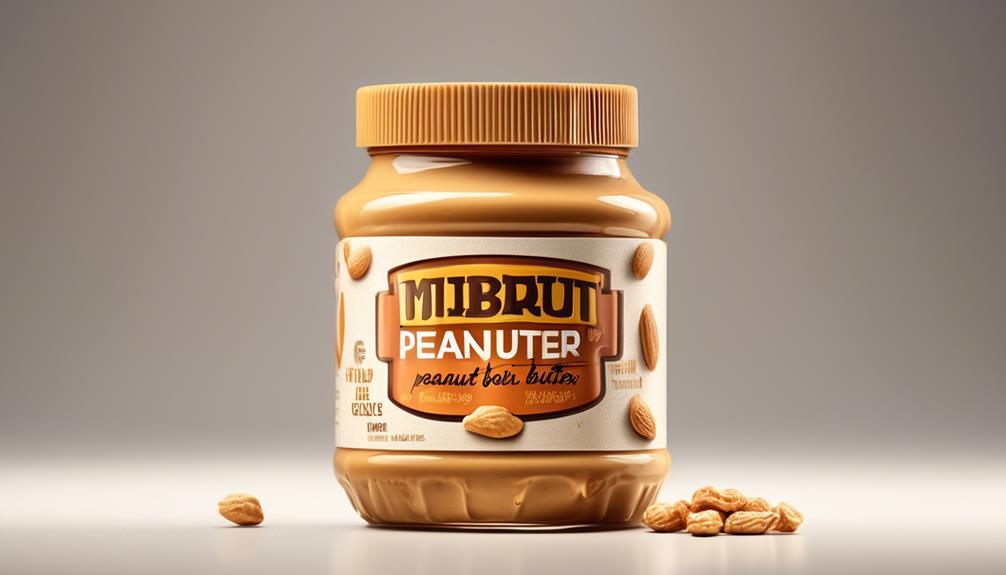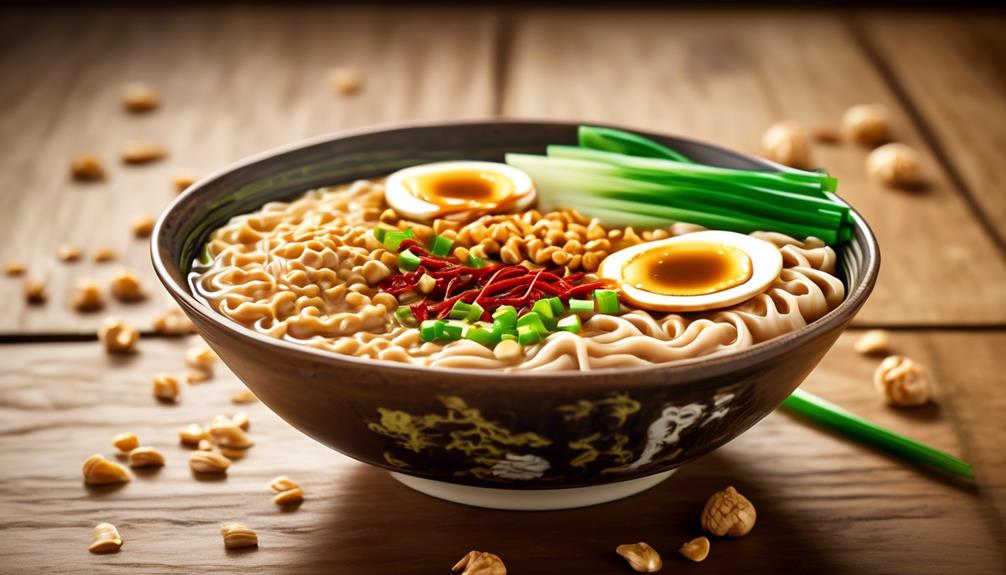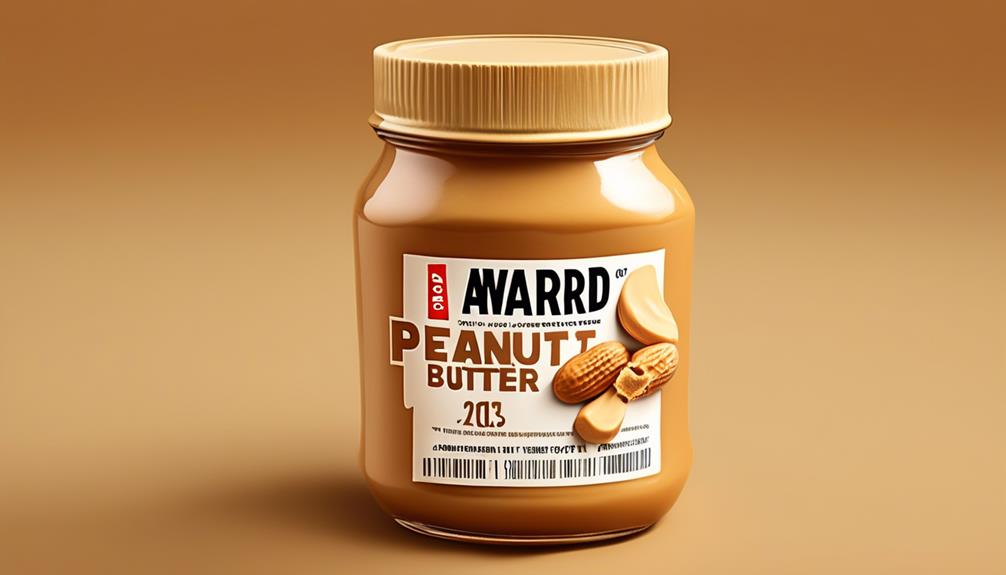We’ve all experienced the moment when we are looking at our pantry and trying to locate the expiration date on our Skippy Peanut Butter jar. It’s a question that has crossed many of our minds at some point.
The answer may not be as straightforward as we think, but fear not, because in this discussion, we'll uncover the elusive location of the expiration date on Skippy Peanut Butter, ensuring that you can enjoy your favorite spread with confidence.
So, where exactly is that expiration date hiding?
Key Takeaways
- Expiration dates on Skippy Peanut Butter signify the manufacturer's assessment of product quality.
- Label placement on the jar is crucial for easy visibility of the expiration date.
- The Best Before date is prominently displayed on the jar for quick reference.
- Reading and adhering to the expiration date ensures optimal taste and quality of Skippy Peanut Butter.
Understanding Expiration Dates
Understanding expiration dates is essential for consumers to make informed decisions about the safety and quality of the products they purchase. The date printed on the jar isn't arbitrary; it signifies the manufacturer's assessment of how long the product will retain its best quality. It's important to note that this date is based on the product being stored according to the manufacturer's guidelines.
Peanut butter, if stored in a cool, dry place and away from direct sunlight, can often be consumed beyond the expiration date without significant risk. However, it's always best to adhere to the expiration date to guarantee the best flavor and quality.
Understanding expiration dates empowers consumers to make informed choices about the products they purchase. It ensures that we consume items at their peak quality and minimizes the risk of consuming products that may have deteriorated in flavor or safety.
Label Placement on Jar

The placement of the label on the SKIPPY® Peanut Butter jar is crucial for easy visibility of the expiration date. The label location ensures that consumers can quickly and clearly identify the Best Before date.
This visibility is essential for ensuring that the product is consumed before it reaches its expiration.
Label Location
The expiration date on Skippy Peanut Butter can be found printed near the rim of the jar's lid or on the label close to the nutritional information. When checking for the expiration date, look towards the top of the lid or the side of the jar near the bottom. Additionally, it's often located on the label, usually near the barcode.
It's important to note that the shelf life of peanut butter can vary depending on storage conditions. Skippy Peanut Butter is best stored at room temperature, but it's essential to know that when refrigerated, the texture can become firmer. Therefore, for optimal quality, it's recommended to consume the product before the expiration date and to store it as indicated on the packaging.
Expiration Date Visibility
Located on the jar for easy visibility, the Best Before date of SKIPPY® Peanut Butter is conveniently printed for quick reference, ensuring the product's freshness. When it comes to expiration date visibility, SKIPPY® Peanut Butter has it covered. The label placement on the jar makes it easy to find and read the expiration date, allowing consumers to check the product's freshness at a glance. This clear and concise labeling ensures that customers can easily determine when the peanut butter should be consumed. By printing the expiration date prominently on the jar, SKIPPY® Peanut Butter helps consumers make informed decisions about the product's shelf life.
- The Best Before date is prominently displayed on the jar for easy visibility.
- Clear label placement makes checking the expiration date simple.
- Consumers can quickly reference the expiration date to ensure product freshness.
SKIPPY® Peanut Butter is at its happiest when stored in a cool, dry place.
Bottom of Jar

When checking the expiration date of SKIPPY® Peanut Butter, it's crucial to look at the bottom of the jar. The location of the expiration date ensures that consumers can easily find and read the information.
Expiration Date Location
On the bottom of the jar is where you'll find the expiration date for SKIPPY® Peanut Butter. It's crucial to check the expiration date before consuming the product to ensure its freshness and quality.
Here's why the expiration date location matters:
- Convenience: The bottom of the jar is an easily accessible and visible location for the expiration date, making it convenient for consumers to check.
- Freshness Guarantee: The expiration date serves as a guarantee of the peanut butter's freshness and optimal taste, ensuring a satisfying experience when consumed before the indicated date.
- Quality Assurance: Consuming SKIPPY® Peanut Butter before the expiration date guarantees its quality and flavor, providing a delightful culinary experience.
Checking the expiration date on the bottom of the jar is a simple yet important step in enjoying the deliciousness of SKIPPY® Peanut Butter.
Reading Expiration Information
After checking the expiration date on the bottom of the SKIPPY® Peanut Butter jar for freshness and quality, understanding how to read this information is essential for ensuring a satisfying culinary experience. The 'Best Before' date, prominently displayed on the jar's bottom, serves as a guarantee of the product's freshness.
To read the date, simply flip the jar and look for the printed date. It's crucial to enjoy the peanut butter before this date to ensure its optimal taste and quality. The 'Best Before' date is an indispensable indicator, ensuring the freshness and quality of the SKIPPY® Peanut Butter.
Top of Lid

The 'Best If Used By' date on the top of the SKIPPY® Peanut Butter lid ensures optimal freshness and quality for consumers. It's a crucial indicator that guarantees the peanut butter is consumed at its best. Here's what you need to know about the 'Best If Used By' date on the top of the lid:
- Location: The 'Best If Used By' date can be found on the top of the lid of the SKIPPY® Peanut Butter jar. This convenient placement ensures that the expiration date is easily visible and accessible for consumers.
- Significance: The date on the lid indicates the time frame within which the peanut butter should be consumed for the best flavor and quality. It serves as a guide for consumers to enjoy the product at its peak freshness.
- Importance of Checking: It's essential to check the 'Best If Used By' date on the lid before purchasing or consuming the peanut butter. Adhering to this date ensures that the product is enjoyed before it reaches its expiration, guaranteeing a delightful culinary experience.
Side of Jar

Located prominently on the side of the SKIPPY® Peanut Butter jar is the 'Best Before' date, a crucial indicator of the product's freshness and quality. This date is vital to ensure that consumers enjoy the peanut butter at its best.
The 'Best Before' date guarantees the freshness of the SKIPPY® Peanut Butter, reflecting the manufacturer's assurance of its quality up to that specified date. It's important to always check this date before consuming the product to guarantee its optimal taste and texture.
The expiration date information is conveniently located on the side of the jar for easy reference, ensuring that consumers can easily access this important information. By adhering to the 'Best Before' date, consumers can enjoy the full flavor and quality of SKIPPY® Peanut Butter.
It's crucial to consume the product before the expiration date to experience it at its best. Therefore, always remember to check the side of the jar for the 'Best Before' date and enjoy your SKIPPY® Peanut Butter while it's at its peak.
Near Nutrition Facts

We'll take a look at the near nutrition facts on the Skippy Peanut Butter jar.
This includes finding the expiration date location and understanding how to read the label for important information.
Let's explore the points related to expiration date location and label reading to ensure we have a comprehensive understanding of the near nutrition facts.
Expiration Date Location
Positioned near the nutrition facts, the 'Best Before' date on SKIPPY® Peanut Butter containers allows for easy verification of product freshness. This convenient placement ensures that consumers can quickly locate and check the expiration date to guarantee the product's quality.
The prominent display near the nutrition facts makes it effortless to monitor the freshness of SKIPPY® Peanut Butter, promoting consumer confidence in the product's shelf life.
The location of the expiration date, positioned strategically for visibility, emphasizes the brand's commitment to providing accurate and accessible information to its consumers, enhancing the overall experience of using SKIPPY® Peanut Butter.
- The 'Best Before' date is prominently displayed near the nutrition facts for easy visibility.
- Consumers can quickly verify the freshness of the product by checking the expiration date.
- The strategic placement emphasizes the brand's dedication to consumer satisfaction.
Reading the Label
Near the nutrition facts, the 'Best Before' date on SKIPPY® Peanut Butter containers serves as a crucial reference point for consumers to ensure the product's freshness. By checking this date, consumers can guarantee that the product is within its optimal quality and flavor. The 'Best Before' date is conveniently positioned next to the nutrition facts, making it easily accessible for quick reference. Here's a breakdown of the information typically found near the nutrition facts:
| Information | Location |
|---|---|
| Best Before Date | Near Nutrition Facts |
| Expiration Date | Close to Nutrition Information |
| Reference Point | Ensure Product Freshness |
| Accessibility | Conveniently Positioned |
| Quick Reference | Easily Accessible |
This clear labeling approach empowers consumers to make informed decisions about the freshness and quality of their SKIPPY® Peanut Butter.
Packaging Information

The Best Before date, prominently displayed on the SKIPPY® Peanut Butter container, serves as a clear indicator of its expiration date. It's a crucial reference point for ensuring the freshness and quality of the product. Consuming SKIPPY® Peanut Butter before this date guarantees the best taste experience.
The expiration date is easily accessible on the packaging, providing a convenient way for consumers to check the product's shelf life. This date is a key piece of packaging information, and it's important to pay attention to it to enjoy the peanut butter at its best.
Understanding the packaging information, such as the Best Before date, is essential for making informed decisions about the product's freshness and suitability for consumption. It ensures that the product is enjoyed within its optimal period, maximizing the flavor and quality of the peanut butter.
Barcode Area

How does the barcode area on the SKIPPY® Peanut Butter packaging facilitate product identification and information retrieval?
The barcode area plays a vital role in product identification and information retrieval. It's typically located on the back or side of the packaging and consists of a series of black and white lines that encode the product's unique identification code.
When scanned with a compatible device, this code enables quick access to crucial information such as pricing, inventory levels, and specific product details. This facilitates efficient inventory management and seamless point of sale transactions.
Maintaining the integrity of the barcode area is essential to ensure accurate scanning and information retrieval. Any damage or tampering to this area can hinder the scanning process, leading to potential errors in product identification and inventory management.
Batch Code Location
Located on the lid or bottom of the container of SKIPPY® Peanut Butter, the batch code consists of a series of numbers and/or letters that serve as a crucial identifier for quality control and traceability purposes.
When inspecting your SKIPPY® Peanut Butter for the batch code, keep in mind the following:
- Location: The batch code can typically be found near the expiration date or manufacturing information. It may be printed directly on the lid or on the bottom of the container.
- Format: The batch code is usually a combination of numbers and letters, serving as a unique identifier for each production batch. This code is essential for tracking the product's manufacturing history and ensuring quality control.
- Importance: Locating the batch code is vital for quality control and traceability purposes. In the rare event of a product issue, the batch code helps the manufacturer trace the specific batch and quickly address any concerns.
If you encounter any difficulty locating the batch code, refer to the product packaging or reach out to the manufacturer for assistance. Remember, understanding and utilizing the batch code ensures that you can confidently track the quality and origin of your SKIPPY® Peanut Butter.
Contacting Customer Service

If you have encountered any issues with your SKIPPY® Peanut Butter, it's advisable to promptly seek assistance by utilizing the customer service contact information provided on the packaging or official website. When reaching out to customer service, consider providing specific details about the product, such as the batch code or expiration date, along with a clear description of the issue you're experiencing. This will help the customer service team better understand your concerns and provide a more efficient resolution.
You can contact SKIPPY® Peanut Butter customer service through various channels, including email, phone, or social media. When communicating, it's important to keep track of any reference numbers or case IDs provided during your interaction for future follow-ups. If you choose to contact customer service by phone, consider calling during non-peak hours for quicker assistance, as wait times may vary.
Frequently Asked Questions
How Long Does Unopened Skippy Peanut Butter Last?
Unopened Skippy Peanut Butter lasts for about 12 months. We ensure its freshness and quality by consuming it before the Best Before date, which is clearly printed on the packaging. It's vital to enjoy it before the expiration date to savor its best taste.
Checking the expiration date is easy, as it's clearly indicated on the container. So, make sure to indulge in the peanut butter before the Best Before date for the best experience.
Does Peanut Butter Have an Expiration Date?
Oh, absolutely, peanut butter does have an expiration date. It's crucial to check the Best Before date on the container for peak freshness and quality.
Consuming SKIPPY® Peanut Butter before this date guarantees the best flavor and texture. It's printed right on the container for easy reference.
Enjoying it before the expiration date ensures you get the most out of your peanut butter experience.
How Do I Know if My Skippy Peanut Butter Is Recalled?
We can check if our Skippy Peanut Butter is recalled by verifying the UPC and Best If Used By dates on the jar lid. If they match the specified details, it's advisable to return the product to the store or contact Skippy Foods Consumer Engagement at 1-866-475-4779.
This is crucial as the recall only affects specific SKIPPY® Reduced Fat Peanut Butter Spread and SKIPPY® Creamy Peanut Butter Blended with Plant Protein products with certain UPC codes and Best If Used By dates.
What Are the Black Specks in Peanut Butter?
The black specks in peanut butter are natural and harmless. They're typically pieces of the peanut skin and don't indicate spoilage.
These specks are common in natural, unprocessed peanut butter and can actually enhance its texture and flavor.
Conclusion
In conclusion, finding the expiration date on Skippy Peanut Butter is essential for ensuring its freshness.
Remember, the 'Best Before' date can be located on the side of the jar, near the barcode area.
Checking this date will guarantee that you enjoy the full flavor and quality of the product.
So, next time you reach for that jar of peanut butter, take a moment to check the side for the expiration date, and savor every delicious bite.
